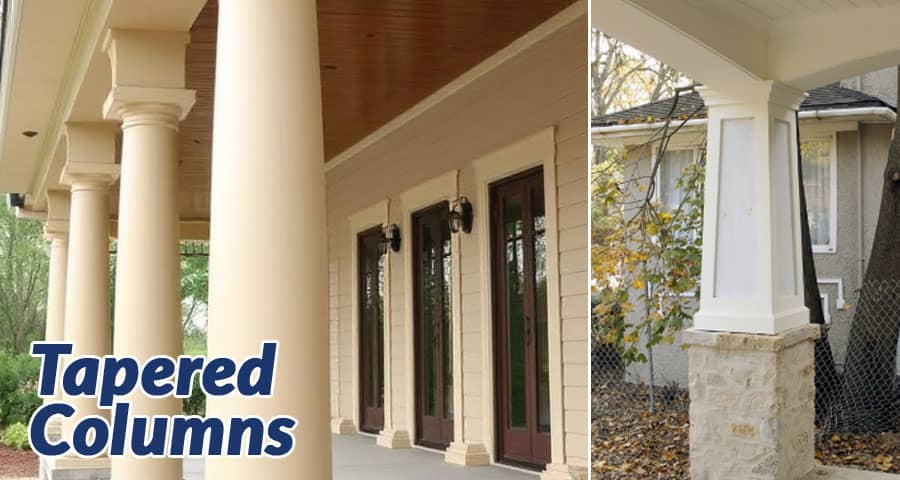What Are Tapered Columns, and Where Are They Commonly Used?

Tapered columns are structural elements whose cross-sectional dimensions gradually decrease from the base towards the top. Unlike uniform columns, tapered columns optimize material use, enhance architectural aesthetics, and improve load distribution. The subtle reduction in size helps to minimize dead loads and increase stability, offering both functional strength and visual appeal in construction.
Typically crafted from steel, concrete, or composite materials, tapered columns are precisely engineered to match specific load-bearing requirements. Their design improves structural efficiency by directing loads smoothly to the foundation, thereby reducing bending moments and enhancing overall building resilience.
Key Features of Tapered Columns
- Material Efficiency: Less material is required at the top where the structural load is lighter.
- Enhanced Aesthetics: The slender, narrowing profile delivers a more elegant appearance.
- Improved Load Distribution: Structural loads are more effectively managed from top to base.
- Reduced Buckling Risks: The variable cross-section enhances resistance to buckling.
- Customization Flexibility: Tailored to fit specific architectural and structural demands.
Types of Tapered Columns
Straight Tapered Columns
Straight tapered columns feature a consistent, linear reduction in cross-section from base to top. These are commonly employed in industrial buildings, warehouses, and storage facilities, where straightforward design aligns with functionality.
Curved Tapered Columns
Curved or parabolic tapered columns display a more gradual, nonlinear taper. They are often seen in high-end architectural projects where aesthetics are a priority, such as luxury hotels, civic centers, and museums.
Multi-Tapered Columns
Multi-tapered columns exhibit varied tapering segments, adjusting angles at different points along their height. This type offers enhanced load adaptability and is frequently utilized in complex engineering structures like stadiums and large exhibition halls.
Materials Commonly Used for Tapered Columns
Steel Tapered Columns
Steel is favored for its strength-to-weight ratio, ease of fabrication, and ability to support significant loads with minimal cross-sectional area. Pre-engineered metal buildings frequently incorporate steel tapered columns for cost-effectiveness and durability.
Concrete Tapered Columns
Concrete tapered columns offer exceptional fire resistance and compressive strength. They are prevalent in high-rise structures, public buildings, and monuments, where longevity and low maintenance are critical factors.
Composite Tapered Columns
Composite columns, often a combination of steel and concrete, bring together the best properties of both materials. These are used in bridges, airports, and urban skyscrapers demanding high performance under dynamic loads.
Where Tapered Columns Are Commonly Used
Pre-Engineered Metal Buildings (PEMBs)
PEMBs leverage tapered columns extensively to reduce costs, optimize design, and maximize usable space. In these buildings, tapered columns efficiently transfer loads while minimizing material usage.
Architectural Landmarks
Iconic structures such as stadiums, arenas, and cultural centers employ tapered columns not only for structural support but also to create distinctive silhouettes. The visual impact of tapering enhances the grandeur and uniqueness of these landmarks.
Bridges and Overpasses
In bridge engineering, tapered columns help in mitigating wind forces, earthquake impacts, and traffic loads. Their shape enhances aerodynamic efficiency, crucial for long-span bridges exposed to variable environmental conditions.
High-Rise Office Buildings
High-rise office towers frequently incorporate tapered columns to manage vertical loads effectively while freeing up interior space. The slender taper permits larger open floor plans, highly desirable in modern commercial architecture.
Shopping Malls and Entertainment Complexes
Large public spaces like malls and theaters benefit from the open areas that tapered columns enable. Their design allows for fewer obstructions, offering a more flexible and expansive interior layout.
Advantages of Using Tapered Columns
Economic Benefits
The strategic reduction of material saves on construction costs without compromising structural integrity. In large-scale projects, these savings become substantially significant.
Structural Optimization
Tapered columns allow for efficient load management, leading to smaller foundations and lighter building frames. This contributes to faster construction times and lower overall project costs.
Design Versatility
The ability to vary taper ratios and shapes means that engineers and architects can meet both technical and aesthetic requirements. Tapered columns fit seamlessly into diverse design languages, from minimalist to ornate.
Sustainability
Using fewer resources reduces the building's environmental footprint. Moreover, lighter structures mean lower transportation and handling costs, further promoting sustainable construction practices.
Design Considerations for Tapered Columns
When designing tapered columns, several factors must be meticulously evaluated:
- Load Path and Distribution: Understanding how loads flow through the column to the foundation.
- Buckling Resistance: Ensuring the taper profile maintains stability under various load conditions.
- Connection Details: Accurate detailing where columns meet beams, slabs, or foundations.
- Architectural Integration: Harmonizing the column's appearance with the overall design vision.
- Fabrication and Installation: Designing columns that are easy to manufacture and assemble on-site.
Sophisticated software tools like Finite Element Analysis (FEA) are often employed to simulate the performance of tapered columns under different loading scenarios, ensuring precision and safety.
Conclusion
Tapered columns represent a perfect balance of structural efficiency, economic value, and aesthetic appeal. Whether in industrial facilities, iconic skyscrapers, or graceful bridges, tapered columns stand as a testament to engineering innovation and architectural excellence. Their strategic use across a wide range of applications continues to shape the skylines and infrastructures of our modern world.
Please watch following short video for Tapered Columns
